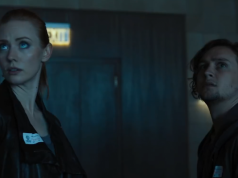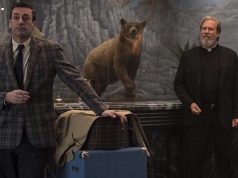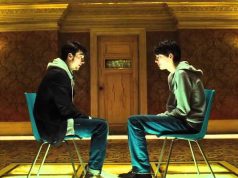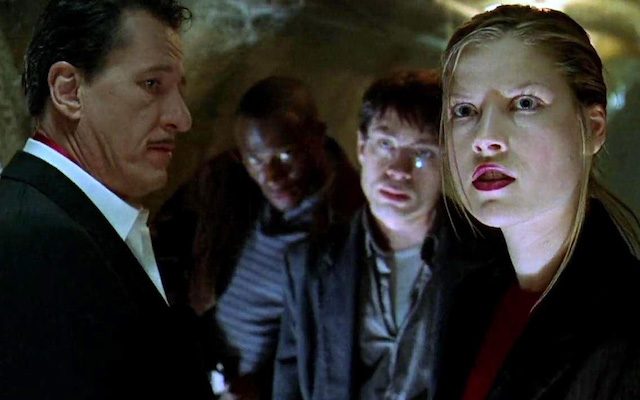
Among the many disappointing things about “The House on Haunted Hill” is that it promises a haunted hill and doesn’t deliver one. Oh, the house is haunted, sure. The house is haunted from here to next Tuesday. But the hill? Just a normal hill. Nothing strange about it except that it has a haunted house on top of it, which isn’t the hill’s fault. Leave the poor hill out of this!
Some of the other disappointing things about “The Haunted House on Normal Hill” are that it’s dumb and not scary and has Chris Kattan in it. It’s a “remake” of a 1959 semi-classic that starred Vincent Price, in the sense of “remake” that means they abandoned most of the original story but named a character after Vincent Price in order to stave off charges of disrespect. “We love the 1959 original!” the filmmakers would say in their defense. “We paid tribute to it by changing everything and gave the main character the last name Price!”
That’s Stephen H. Price, to be exact, played by moist, succulent Australian ham Geoffrey Rush. Price is an amusement park tycoon who hates his beautiful wife, Evelyn (Famke Janssen), who hates him right back and is only married to him for his money. Evelyn sees a TV show about an old asylum that got shut down in the 1930s after its head doctor was found to be experimenting on the patients and a lot of people got killed, and she figures this would be the perfect place for her next birthday party. (The haunted Chuck E. Cheese where all those kids died was already booked.) She reports her desires to Stephen, who agrees to throw her a fine soiree at the creepy sanitarium, shreds her guest list, and invites other people instead.
But someone else (Satan?) has other ideas! After Stephen H. Price enters his modified guest list into his laptop, a ghost or something comes along and replaces the names with other names, and those people get invited instead. Which means the party is not attended by Evelyn’s friends, nor by whoever it was that Price tried to invite, but by total strangers who do not know why they’ve been invited. What a fun party! Wheeeee!
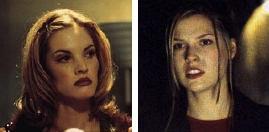
The guests are: Watson Pritchett (Chris Kattan), whose family owns the defunct property and is renting it to the Prices; Eddie Baker (Taye Diggs), a former pro athlete whose first line of dialogue is “G–damn, this house is scary, yo!,” which is the movie’s way of letting you know that he’s The Black Guy; Donald Blackburn (Peter Gallagher), a doctor; a businesswoman named Sara; and a D-list local media celebrity named Melissa. Sara and Melissa are played by Ali Larter and Bridgette Wilson, identical blondes with identical “Who farted?” expressions on their faces all the time.
Price’s plan is to scare everybody with spook-house gimmicks and offer a $1 million reward to anyone who stays in the asylum all night. Evelyn’s plan is to talk about how much she hates her husband and make disparaging remarks about his sexuality. Pritchett doesn’t care about the reward and wants to leave NOW; the other four are keen on staying in order to collect their easy prize. Wouldn’t you know it, the building immediately goes into “lockdown” mode, with steel barriers sliding down to block all the doors and windows. This is a leftover precaution from when it was an insane asylum; it’s also how theater owners kept patrons from escaping when this film was showing. Price didn’t activate the lockdown, though, and doesn’t know how it happened. Naturally, someone must descend into the building’s dark, sinister, cobwebby basement to investigate and/or get killed.
Hoo boy, lotsa supernatural activity down in that basement! Nothing that follows a cohesive narrative formula, mind you, just lots of random spooky things. (“Eh, whatever seems vaguely creepy!” is what the director told the production designer, who was on crystal meth.) Sara thinks she sees Eddie jump into a giant vat of blood. As she’s reaching in to pull him out, the real Eddie arrives and asks what the heck she’s doing. That’s a good question! Other good questions include what is in the vat pulling on Sara’s arm when she reaches in, and why is there a giant vat of blood in the basement in the first place, and why do Sara and Eddie both disregard the entire incident without further discussion. Meanwhile, Melissa the would-be media star wanders around with a camcorder and sees things in the viewfinder that aren’t actually there. Guns presumed to have been loaded with blanks mysteriously have real bullets. Images of dead asylum inmates appear and then disappear. Charges appear on the satellite bill for pay-per-view movies that nobody ordered!
Pritchett, the Chris Kattan character, keeps insisting that the place is possessed by malevolent spirits — that the house itself wants them all dead. This information is correct but unhelpful: they can’t get out of the house anyway, so it doesn’t matter who’s trying to kill them. Pritchett would do well to shut up, especially if he’s going to keep speaking with Chris Kattan’s voice, a grating, nasal baritone that is itself responsible for countless deaths.
This brings us to the film’s major obstacle. It wants to be the sort of movie where a lot of people die in a gory fashion. But it only has seven characters, and at least one of them, preferably one of the blondes, is required by Hollywood law to still be alive at the end. The movie’s workaround for this scarcity of victims is twofold. One, we see bloody flashbacks to 1930s mayhem, when the inmates got fed up and attacked the crazy doctor and his staff. Two, some of the characters in the present die more than once. Evelyn is found electrocuted to death by ghosts — which makes Price very angry, even though he hated her — and is subsequently revived by Dr. Donald Blackburn, with whom she had conspired to fake her death in order to trick Price. Then she is killed for real by the house’s dark energy, which takes the form of a black cloud, like the one that hovers around Pigpen. Likewise, Price is shot several times in the chest, and we are encouraged to believe he’s dead for several minutes before it’s revealed that the gun had blanks and he was using squibs to fake everybody out, whereupon he is also killed by the house.
Perhaps you are wondering how the angry house chose these particular people to invite to Evelyn’s birthday party. The movie is glad you asked! It’s because they’re all descendants of people who worked with Crazy Experimenting Doctor, and they must be punished for their ancestors’ crimes. This is not entirely fair, but try telling the house that. The house has a very Old Testament philosophy when it comes to the sins of the fathers being answered upon the heads of the children. Let’s be honest, the house is as insane as its former occupants were — maybe more so, comparatively speaking, since the sanity baseline for edifices is so much lower than for people. I mean, a person acts a little squirrelly and you think, “Ha, well, it takes all kinds to make a world.” But when a house behaves strangely you think, “Holy crap, this place is BANANAS!,” and you call a priest.
Anyway, the point is this: the house is bad, not the hill. Maybe that’s not supposed to be the point, but it’s the message I took away from it. The hills in “The Hills Have Eyes” don’t have eyes, either. The people who live in the hills do. I’m tired of liberal Hollywood taking out its prejudices on innocent hills, and I won’t stand for it anymore.
— Film.com


